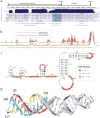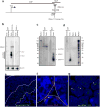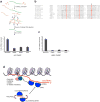Identification and Characterization of a Class of MALAT1-like Genomic Loci
- PMID: 28538188
- PMCID: PMC5505346
- DOI: 10.1016/j.celrep.2017.05.006
Identification and Characterization of a Class of MALAT1-like Genomic Loci
Abstract
The MALAT1 (Metastasis-Associated Lung Adenocarcinoma Transcript 1) gene encodes a noncoding RNA that is processed into a long nuclear retained transcript (MALAT1) and a small cytoplasmic tRNA-like transcript (mascRNA). Using an RNA sequence- and structure-based covariance model, we identified more than 130 genomic loci in vertebrate genomes containing the MALAT1 3' end triple-helix structure and its immediate downstream tRNA-like structure, including 44 in the green lizard Anolis carolinensis. Structural and computational analyses revealed a co-occurrence of components of the 3' end module. MALAT1-like genes in Anolis carolinensis are highly expressed in adult testis, thus we named them testis-abundant long noncoding RNAs (tancRNAs). MALAT1-like loci also produce multiple small RNA species, including PIWI-interacting RNAs (piRNAs), from the antisense strand. The 3' ends of tancRNAs serve as potential targets for the PIWI-piRNA complex. Thus, we have identified an evolutionarily conserved class of long noncoding RNAs (lncRNAs) with similar structural constraints, post-transcriptional processing, and subcellular localization and a distinct function in spermatocytes.
Keywords: Anolis carolinesis; MALAT1; PIWI; evolution; lizard; long noncoding RNA; piRNA; tRNA-like; testis; triple helix.
Copyright © 2017 The Author(s). Published by Elsevier Inc. All rights reserved.
Figures







Similar articles
-
tRNA-like leader-trailer interaction promotes 3'-end maturation of MALAT1.RNA. 2021 Oct;27(10):1140-1147. doi: 10.1261/rna.078810.121. Epub 2021 Jul 12. RNA. 2021. PMID: 34253686 Free PMC article.
-
Structural basis of MALAT1 RNA maturation and mascRNA biogenesis.Nat Struct Mol Biol. 2024 Nov;31(11):1655-1668. doi: 10.1038/s41594-024-01340-4. Epub 2024 Jul 2. Nat Struct Mol Biol. 2024. PMID: 38956168
-
A triple helix stabilizes the 3' ends of long noncoding RNAs that lack poly(A) tails.Genes Dev. 2012 Nov 1;26(21):2392-407. doi: 10.1101/gad.204438.112. Epub 2012 Oct 16. Genes Dev. 2012. PMID: 23073843 Free PMC article.
-
The long noncoding RNA Malat1: Its physiological and pathophysiological functions.RNA Biol. 2017 Dec 2;14(12):1705-1714. doi: 10.1080/15476286.2017.1358347. Epub 2017 Oct 6. RNA Biol. 2017. PMID: 28837398 Free PMC article. Review.
-
Long noncoding RNAs: Novel insights into hepatocelluar carcinoma.Cancer Lett. 2014 Mar 1;344(1):20-27. doi: 10.1016/j.canlet.2013.10.021. Epub 2013 Oct 30. Cancer Lett. 2014. PMID: 24183851 Review.
Cited by
-
The Potential Links between lncRNAs and Drug Tolerance in Lung Adenocarcinoma.Genes (Basel). 2024 Jul 11;15(7):906. doi: 10.3390/genes15070906. Genes (Basel). 2024. PMID: 39062685 Free PMC article. Review.
-
mascRNA and its parent lncRNA MALAT1 promote proliferation and metastasis of hepatocellular carcinoma cells by activating ERK/MAPK signaling pathway.Cell Death Discov. 2021 May 17;7(1):110. doi: 10.1038/s41420-021-00497-x. Cell Death Discov. 2021. PMID: 34001866 Free PMC article.
-
Ribosomes guide pachytene piRNA formation on long intergenic piRNA precursors.Nat Cell Biol. 2020 Feb;22(2):200-212. doi: 10.1038/s41556-019-0457-4. Epub 2020 Feb 3. Nat Cell Biol. 2020. PMID: 32015435 Free PMC article.
-
Unraveling the structure and biological functions of RNA triple helices.Wiley Interdiscip Rev RNA. 2020 Nov;11(6):e1598. doi: 10.1002/wrna.1598. Epub 2020 May 22. Wiley Interdiscip Rev RNA. 2020. PMID: 32441456 Free PMC article. Review.
-
Comparative genomics in the search for conserved long noncoding RNAs.Essays Biochem. 2021 Oct 27;65(4):741-749. doi: 10.1042/EBC20200069. Essays Biochem. 2021. PMID: 33885137 Free PMC article.
References
-
- Aravin A, Gaidatzis D, Pfeffer S, Lagos-Quintana M, Landgraf P, Iovino N, Morris P, Brownstein MJ, Kuramochi-Miyagawa S, Nakano T, et al. A novel class of small RNAs bind to MILI protein in mouse testes. Nature. 2006;442:203–207. - PubMed
-
- Aravin AA, Hannon GJ. Small RNA silencing pathways in germ and stem cells. Cold Spring Harb Symp Quant Biol. 2008;73:283–290. - PubMed
-
- Armour CD, Castle JC, Chen R, Babak T, Loerch P, Jackson S, Shah JK, Dey J, Rohl CA, Johnson JM, et al. Digital transcriptome profiling using selective hexamer priming for cDNA synthesis. Nature methods. 2009;6:647–649. - PubMed
Publication types
MeSH terms
Substances
Grants and funding
LinkOut - more resources
Full Text Sources
Other Literature Sources
Molecular Biology Databases

